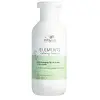What's inside
What's inside
 Key Ingredients
Key Ingredients

 Benefits
Benefits

 Concerns
Concerns

 Ingredients Side-by-side
Ingredients Side-by-side

Water
Skin ConditioningSodium Laureth Sulfate
CleansingCocamidopropyl Betaine
CleansingPEG-7 Glyceryl Cocoate
EmulsifyingSodium Chloride
MaskingHydrolyzed Soy Protein
HumectantGlycine
BufferingLysine Hcl
Skin ConditioningPanthenol
Skin ConditioningDisodium EDTA
Dimethicone
EmollientGlycol Distearate
EmollientHydrogenated Castor Oil
EmollientGuar Hydroxypropyltrimonium Chloride
Skin ConditioningLaureth-4
EmulsifyingSodium Hydroxide
BufferingBenzyl Salicylate
PerfumingLinalool
PerfumingLaureth-23
CleansingHexyl Cinnamal
PerfumingLimonene
PerfumingBenzyl Alcohol
PerfumingPropylene Glycol
HumectantSalicylic Acid
MaskingWater, Sodium Laureth Sulfate, Cocamidopropyl Betaine, PEG-7 Glyceryl Cocoate, Sodium Chloride, Hydrolyzed Soy Protein, Glycine, Lysine Hcl, Panthenol, Disodium EDTA, Dimethicone, Glycol Distearate, Hydrogenated Castor Oil, Guar Hydroxypropyltrimonium Chloride, Laureth-4, Sodium Hydroxide, Benzyl Salicylate, Linalool, Laureth-23, Hexyl Cinnamal, Limonene, Benzyl Alcohol, Propylene Glycol, Salicylic Acid
Water
Skin ConditioningCocamidopropyl Betaine
CleansingSodium Methyl Oleoyl Taurate
CleansingGlycerin
HumectantSodium Lauroyl Sarcosinate
CleansingParfum
MaskingPanthenol
Skin ConditioningPhenoxyethanol
PreservativeSodium Benzoate
MaskingPolyquaternium-10
Citric Acid
BufferingDisodium EDTA
Propylene Glycol
HumectantEthylhexylglycerin
Skin ConditioningCamellia Sinensis Leaf Extract
AntimicrobialTocopherol
AntioxidantSodium Citrate
BufferingIngredients Explained
These ingredients are found in both products.
Ingredients higher up in an ingredient list are typically present in a larger amount.
Cocamidopropyl Betaine is a fatty acid created by mixing similar compounds in coconut oil and dimethylaminopropylamine, a compound with two amino groups.
This ingredient is a surfactant and cleanser. It helps gather the dirt, pollutants, and other impurities in your skin to be washed away. It also helps thicken a product and make the texture more creamy.
Being created from coconut oil means Cocamidopropyl Betaine is hydrating for the skin.
While Cocamidopropyl Betaine was believed to be an allergen, a study from 2012 disproved this. It found two compounds in unpure Cocamidopropyl Betaine to be the irritants: aminoamide and 3-dimethylaminopropylamine. High-grade and pure Cocamidopropyl Betaine did not induce allergic reactions during this study.
Learn more about Cocamidopropyl BetaineDisodium EDTA plays a role in making products more stable by aiding other preservatives.
It is a chelating agent, meaning it neutralizes metal ions that may be found in a product.
Disodium EDTA is a salt of edetic acid and is found to be safe in cosmetic ingredients.
Learn more about Disodium EDTAPanthenol is a common ingredient that helps hydrate and soothe the skin. It is found naturally in our skin and hair.
There are two forms of panthenol: D and L.
D-panthenol is also known as dexpanthenol. Most cosmetics use dexpanthenol or a mixture of D and L-panthenol.
Panthenol is famous due to its ability to go deeper into the skin's layers. Using this ingredient has numerous pros (and no cons):
Like hyaluronic acid, panthenol is a humectant. Humectants are able to bind and hold large amounts of water to keep skin hydrated.
This ingredient works well for wound healing. It works by increasing tissue in the wound and helps close open wounds.
Once oxidized, panthenol converts to pantothenic acid. Panthothenic acid is found in all living cells.
This ingredient is also referred to as pro-vitamin B5.
Learn more about PanthenolPropylene Glycol is an odorless, colorless liquid. As a humectant, it helps skin retain moisture. It also aids in delivering active ingredients.
Another role of this ingredient is preventing a product from melting or freezing. Propylene glycol also adds antimicrobrial properties to a product, elongating product lifespan.
This ingredient is considered an organic alcohol and commonly added into both cosmetics and foods.
Those with sensitive skin or conditions may develop a rash when using this ingredient.
Learn more about Propylene GlycolWater. It's the most common cosmetic ingredient of all. You'll usually see it at the top of ingredient lists, meaning that it makes up the largest part of the product.
So why is it so popular? Water most often acts as a solvent - this means that it helps dissolve other ingredients into the formulation.
You'll also recognize water as that liquid we all need to stay alive. If you see this, drink a glass of water. Stay hydrated!
Learn more about Water